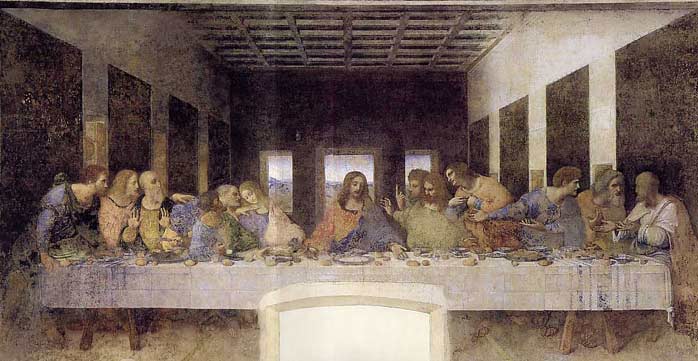Prostitute
- “Sophie turned. 'The prostitute?'
- “Teabing drew a short breath, as if the word had injured him personally.
'Magdalene was no such thing. That unfortunate misconception is the legacy
of a smear campaign launched by the early Church.'”
- (The Da Vinci Code, Dan Brown, Chapter 58).
|
|
It's odd indeed that an author who finds pagan fertility rites the last
word in spirituality sputters so at this identification. That Mary of Bethany was a prostitute is not a "smear,"
but an inference drawn because of the ointment:
“Then one of the Pharisees asked Him to eat with him. And He went to the Pharisee’s house, and sat down to eat. And
behold, a woman in the city who was a sinner, when she knew that Jesus sat at the table in the Pharisee’s house, brought an alabaster
flask of fragrant oil, and stood at His feet behind Him weeping; and she began to wash His feet with her tears, and wiped them with the
hair of her head; and she kissed His feet and anointed them with the fragrant oil. Now when the Pharisee who had invited Him saw this, he
spoke to himself, saying, 'This Man, if He were a prophet, would know who and what manner of woman this is who is touching Him, for she
is a sinner.'” (Luke 7:36-39).
"Then, six days before the Passover, Jesus came to Bethany, where
Lazarus was who had been dead, whom He had raised from the dead. There
they made Him a supper; and Martha served, but Lazarus was one of those
who sat at the table with Him. Then Mary took a pound of very costly oil
of spikenard, anointed the feet of Jesus, and wiped His feet with her hair.
And the house was filled with the fragrance of the oil." (John 12:1-3).
On its face there is nothing impossible in two women doing this same thing
on two different occasions; Luke does not give a locale for his
story but presumably once in Galilee and once in Judaea, the first
occasion earlier in the ministry, the second just before the passion.
Yet John does not speak as if it were a common, repeated act, rather he
seems to think there is one woman who performed this action, on both
occasions:
"Now a certain man was sick, Lazarus of Bethany, the town of Mary and her sister Martha. It was that Mary who
anointed the Lord with fragrant oil and wiped His feet with her hair, whose brother Lazarus was sick."
(John 11:1-2).
If this were of common occurrence, why not say 'Mary was one of those who
anointed the Lord'? His language suggests the anointing is
sufficient to mark out to his readers who he is talking about. There
may be differences in various New Testament accounts, but discrepancies only if one asserts
it is impossible to anoint both head and feet. The woman who poured ointment on the Lord's feet, and head, who
may indeed be the same Mary who was Lazarus' sister, was a flagrant, public "sinner." Her line of work is
not stated. This woman may well be Mary of Bethany, a woman who loved the Lord, and studied His teaching:
"And she had a sister called Mary, who also sat at Jesus’ feet and heard His word."
(Luke 10:39).
Certainly there are many sins, and indeed we are all sinners: ". . .for all have sinned and fall short of the glory
of God. . ." (Romans 3:23). People criticize the 'Religious Right' for focusing on sexual sins to the exclusion of all other sins,
but in fact people have always homed in on these sins. It is unlikely that a woman who was branded a "sinner" was notorious
for avarice, say, or calumny. And yet she cannot have been a known axe murderer or bank robber, or she would not have been on the loose.
The idea that she was a courtesan fits the known facts.
Now, to the next issue: is Mary of Bethany the same woman as Mary Magdalene,
i.e. Mary of Magdala (in Galilee)?
If it is not this woman whom the gnostic gospels portray as teaching others
what she had learned at Jesus' feet, then who? What other woman "sat
at Jesus' feet"? It appears that the gnostic authors identified Mary
Magdalene with Mary of Bethany; whence else comes Mary Magdalene's license
to teach? Though our author thinks highly of the gnostic authors, he dislikes their identification.
The case that Mary of Bethany and Mary of Magdala must be two different women runs as follows: Luke brings up Mary Magdalene in
Chapter 8 of his gospel without any apparent awareness he has just told a long story about the same party. Moreover, Bethany and Magdala
are both place names. They are not the same place. Therefore Mary of Bethany and Mary of Magdala cannot be the same woman. But people move.
We talk about Jesus of Nazareth, but Jesus of Bethlehem gives his natal place. Why not Jesus of Jerusalem? That is where He was put to
death, and the present-day bishop of Rome styles himself 'Peter' for no better reason than because Peter was put to death in that place.
Commentators who lived in that day and were familiar with how these tags work did not hesitate to identify Mary of Bethany with Mary
Magdalene. Modern commentators are more reticent.
Though it seems counter-intuitive, people identified by a
place-name in the period often did not reside at that place: "The
many parallels to a place of origin as an identifying second name,
from ossuaries and other Second Temple period sources, all seem to
refer to a place from which the individual or the family came before
living elsewhere." (Richard Bauckham, Jesus and the Eyewitnesses, p.
106). Say there are five 'Phil's' living in Podunk. Calling each
'Phil from Podunk' gets you nowhere in terms of differentiating
them. You want to specify exactly which 'Phil' you mean, but they
are all 'from Podunk.' But if one was originally 'from away,'
calling him 'Phil from East Overshoe,' is accurate, easily
remembered, and does serve to distinguish him from the others. So if
she's Mary 'Magdalene,' that does not stick her in Magdala for life.
Some early commentators were biased toward identifying persons who turn up in the New Testament, if there is any basis
for so doing, such as the same name or similarities in the description of an incident. Some modern commentators are biased against. In the
nature of things, these identifications cannot be proven beyond a reasonable doubt. However, we are talking about a public ministry
that spanned but three years. Though Jesus drew crowds of thousands, His inner circle was smaller. One hundred and twenty persons
assembled in the upper room (Acts 1:15). In a core group numbering one hundred and twenty, what are the odds that each 'Mary' you
come upon is new and not familiar? Is there actually an infinite pool of 'Mary's'? Looking to plausibility rather than to an unattainable
standard of proof, the strategy of identification is defensible.
One should be careful to avoid the anachronism of assuming the
frequency of name distribution in antiquity was the same as now.
Certainly the student of Carthaginian history who, hearing about
'Hannibal,' 'Hamilcar,' and 'Hanno,' says, 'Oh yeah, I know that
guy,' will meet with shipwreck, because this society recycled names.
Some modern readers do take this strategy, of collapsing all
same-named persons into one, meeting at times with ridiculous
results. This popular modern author, for instance, is too canny to
be fooled by the gospel presentation that Jesus had a brother named
James, and there is also an apostle so-named, who is not the same
person: "Simultaneously, his double and namesake, the confusing
'James the brother of John,' as we saw, is conveniently eliminated
from the narrative." (Robert Eisenman, James the Brother of Jesus,
p. 413). The evidence of the ossuaries, however, is that 'Jacob'
actually was a common name.
The once popular 'identify-if-possible approach is no longer
widely accepted by church folk, and with some reason. Archaeological
inscriptions show that 'Mary' was indeed such a popular name in first century
Judaea that, if you called out 'Miriam!' on the street, fully one quarter
of the female populace would have turned their heads. Had the early church
authors been fully aware of how common the name was, they might have seen
the futility in identifying Mary Magdalene with Mary of Bethany. But their
motives were not impure. There is an advance in economy in identifying two
figures who at first glance seem distinct; it is not an evil thing
to do. And it is at least conceivable that this actually is one and
the same individual.
When the Lord arose, on Sunday, the first day of the week, He appeared
to Mary Magdalene: "Now when He rose early on the first day of the
week, He appeared first to Mary Magdalene, out of whom He had cast seven
demons." (Mark 16:9). That this is the same woman who poured ointment
on the Lord's feet cannot be proven to forensic standards. But to suppose
she is not does require one to believe that Mary the sister of Lazarus,
who loved the Lord, deserted Him in His time of need, because if she is
not "Mary Magdalene," she is nowhere to be found at cross or tomb.
Where was she? What kind of friend, knowing that her friend is
suffering a tortured death not far from her home, sits at home
unmoved? To think that it was so is sad. Certainly, you find out who
your friends are when you're in trouble! "Now Jesus loved Martha and
her sister and Lazarus." (John 11:5). Those committed to dividing
Mary of Bethany from Mary Magdalene imply it was unrequited. The ancients could not bring themselves
to believe that. Why would she have stayed away? Was it because Lazarus
was on Jerusalem's Most Wanted List?: "But the chief priests plotted
to put Lazarus to death also, because on account of him many of the Jews
went away and believed in Jesus." (John 12:10-11). His sister may
have felt laying low was the only way to avoid leading the authorities
to her brother. Then she loved her brother better than she loved Jesus.
Still one really cannot prove the point one way or the other. We are
in the realm of probabilities, not certainties.
The traditional understanding is remarkable. A reformed prostitute
was the first person to see the risen Lord. Why is our author so uncharitable
that he assumes no woman who has ever been a prostitute can thereafter amount
to anything or be worth anything? The early church authors were not so judgmental.
The identification of Mary of Bethany with Mary Magdalene finds
defenders today: "Mary Magdalene and Mary of Bethany never appear on
the stage together. . .Why invent another Mary when Mary of Bethany
is so perfectly portrayed? The one who loved much, the one whose
action was to be remembered wherever the gospel was preached
throughout the whole world, was also surely the one who first saw
the Lord." (John Wenham, Easter Enigma, p. 29).
In either case, the accusation of ill-will against those who identify the
two Mary's is unfounded. Those commentators who follow the strategy of
identification do so consistently, not just in this one case. They identified
Mary of Bethany with Mary of Magdala because they tended to identify personages
of the same name if it was possible to do so, not because they were smear artists. It is odd that Dan Brown is so zealous to defend the woman's honor, because others
who have promoted the same gnostic template he is using have thought the whole point was that the woman was
a prostitute:

|




